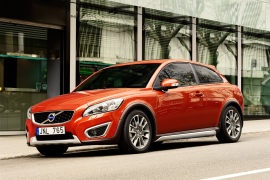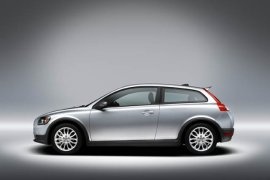
VOLVO C30
Generations Timeline, Specs and Pictures

Being absent from the hatchback-coupe market with the latest model released in the 70’s, Volvo designed the C30, a 2-door hatchback with retro accents borrowed from the 1800ES such as the large trapezoidal glass hatch.
The boxy nose and the grille were also kept and redesigned for a more modern look.
The underpinnings of the C30 were the S40’s, sharing the same wheelbase. The C30 was shorter than the Volvo’s S40 sedan.
Under the hood, the C30 was equipped with a 2.5-liter engine that developed no less than 227 hp.
The power was sent to the front wheels through a 6-speed manual or a 5-speed automatic transmission.
Two trim levels were offered with the C30, the T5 and the T5 R-design.
The base trim level offered 17-inch alloys, a telescopic steering wheel with audio controls and an 8-speaker audio system that featured an AUX jack.
The R-Design came with larger 18-inch alloys wheels and a sport-tuned suspension, cruise control and a better 10-speaker audio system and dedicated exterior accents.
As expected, the C30 featured many safety systems to ensure passenger protection. The C30 came with antilock disc brakes, stability control, traction control, front-seat side airbags and side airbags. An optional Blind Spot Information System was available.

The C30 was one of Volvo’s most daring projects under Ford’s management, and it was a spectacular hatchback offered in only one body shape.
In 2001, Volvo showcased the Safety Concept Car, or SCC, at the Detroit Motor Show, which featured a revolutionary concept of see-through A-pillars and an interior designed for women, with a dedicated storage area for a purse. Peter Horbury, Volvo’s chief designer, stated that “Concept cars are an excellent way of providing a glimpse of the future without being constrained by a specific design. They help us to make wise decisions in our development work.” Five years later, the Swedish carmaker introduced the C30 as a production-ready model at the Paris Motor Show.
The compact hatchback featured a front area similar to those found on other Volvo models, but its main ingredient was the rear windscreen. It was the only car on the market that didn’t feature a tailgate. Only the big glass area was opening, resembling the former glory Volvo P1800SE. Its sculptured hood featured a V-shaped taller center side. From the profile, it showed its unusual shape, especially for a Volvo. The raked-forward C-pillars and the rear windows exposed a fresh design idea, with tall taillights mounted left and right of the rear windscreen.
Inside, Volvo installed a floating-design for the center stack, with a storage compartment behind it. The C30 carried over the SCC idea from the SCC, and later on, it was implemented on other Volvo vehicles. Horbury said that it is a car for someone who doesn’t have children, enjoys an active lifestyle, and wants to try something different. The C30 offered plenty of room for the front passengers and very limited for the rear ones.























































